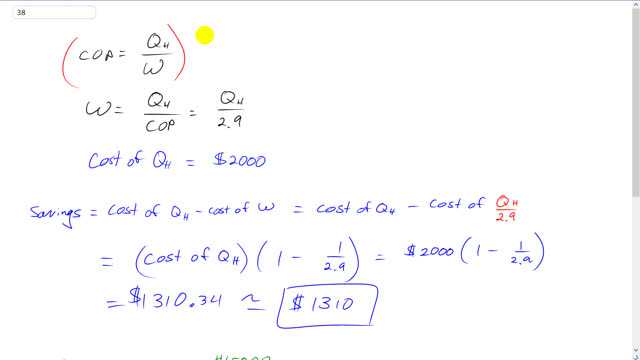
How much less per year would it cost a family to operate a heat pump that has a coefficient of performance of 2.9 than an electric heater that costs $2000 to heat their home for a year? If the conversion to the heat pump costs $15,000, how long would it take the family to break even on heating costs? How much would the family save in 20 years?

In order to watch this solution you need to have a subscription.
This is Giancoli answers with Mr. Dychko. The coefficient of performance for a heat pump is the amount of heat energy delivered to the high temperature reservoir divided by the work that it takes to run the pump. And we can solve this for W by multiplying both sides by W over COP and here W is Q H over coefficient of performance which is Q H over 2.9. Now, we know the cost of this much energy is 2000 dollars based on the scenario where you're just using electric baseboard heating and so the savings of having a heat pump is that the heat pump needs only this much energy to run W which we found out is Q H over 2.9. So, the savings will be the cost of this much energy, Q H directly which is 2000 dollars minus the cost of the amount of energy equal to W which is the scenario where you have a heat pumping being used. So, the heat pump gives you… it brings in extra energy from the low temperature reservoir as a result of doing some work W and you get a total energy delivery equal to W plus Q L, there's that schematic here we have a low temperature reservoir and a high temperature reservoir and you have some energy flow Q L here being moved as a result of this input of W. And together they make Q H that goes into the high temperature reservoir. Anyway so the cost of Q H minus the cost of Q H over 2.9 is going to be your savings because we can substitute Q H over 2.9 in place of W and then we can factor out the cost of Q H which is a common factor between these two terms. So we've cost of Q H times one minus one over 2.9. So that’s 2000 dollars times one minus one over 2.9 which is 1310 dollars. That's the savings per year and if the cost of installation was 15000 dollars, we take the savings per year multiplied by the number of years and that has to equal 15000, so that’s 15000 divided by the savings per year, 1310 and that gives about 11.45 years and let's just call it 11 years and after 20 years you have this much savings per year multiplied by 20 years for total operating savings after 20 years minus the one time cost of installation because it’s all savings of 11000 dollars after 20 years.